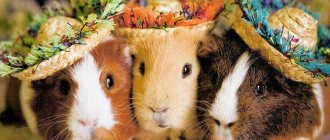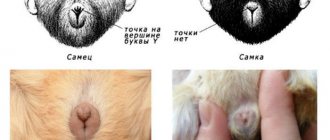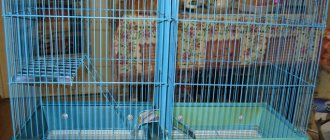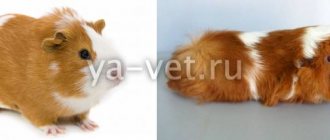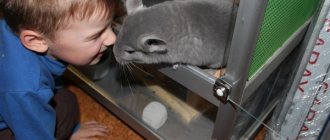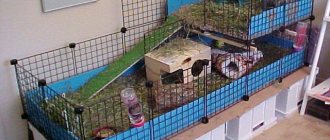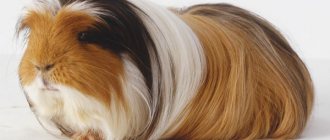How to properly breed guinea pigs - features of the reproductive system of rodents and genes that provide color to the cubs. How to prepare animals for crossing. Caring for a pregnant female and newborn offspring.
Guinea pigs have lived side by side with humans since the 5th millennium BC. These rodents are distinguished by their flexible nature and friendly disposition. Therefore, they are one of the most common pets in many countries. Today there are more than 20 cavy breeds. Knowing the peculiarities of crossing guinea pigs at home, even a novice breeder can breed them.
Puberty
The onset of reproductive function in guinea pigs begins at 2 months. However, there is no need to rush into getting offspring. At such a young age, the female’s body is not yet fully strong enough to bear offspring and give birth. It is better to wait until your pet is at least six months old. There is also no point in delaying procreation. Late motherhood often causes hormonal imbalance.
Until mating, future parents must be kept in separate cages. Guinea pigs are characterized by increased sexual activity. If a female and a male live together, the breeding process will get out of control and will continue continuously.
Important! The interval between births should be at least 6 months. This time is quite enough for the complete restoration of the female’s body.
Estrus
A female guinea pig is only ready to conceive within 12 hours of the start of her heat, which occurs every 14-18 days. The period favorable for fertilization can be determined by the following characteristics:
- the pig's genital loop swells;
- mucus discharges from the vulva;
- the pet raises the back of its body when stroking it;
- the pig makes a characteristic inviting rumbling sound.
You should also observe the female’s mood. Under normal conditions, rodents do not let males get close and often show aggression. During the period of estrus, the pig's behavior changes, she becomes more lenient and supportive of her boyfriend.
Shark
Outrage over the consumption of shark meat is common. However, the biggest rage in particular is shark fin soup, a delicacy very popular in China and Taiwan. The method of extracting fins is particularly cruel. Sharks are caught, their fins are cut off, and then they are thrown into the water while still alive, where the animals simply suffocate or are eaten by other predators. In 2011, Gordon Ramsay made a documentary special for Channel 4 called Shark Bait, which depicted the cruelty and inhumanity of shark finning. After tasting the soup, Ramsay said the fin was bland and tasteless.
Genes responsible for color
Knowing the characteristics of the genes responsible for coat color, breeders can easily obtain offspring of guinea pigs of the desired color. The main genes that determine the color of future babies have the following designations:
- A - agouti;
- B – brown;
- C – color intensity;
- E – black and red colors;
- P – pink eyes and weak pigmentation;
- S – white.
The listed genes give rise to many mutations, the main types of which are presented in the table:
| Gene | Mutation | ||
| B | b | — | Brown coloring and ruby eyes |
| C | c(d) | — | Reduced color intensity: brown and gray tones instead of black |
| c(k) | — | Strong lightening of the base color | |
| c(r) | — | Neutralizes red pigments | |
| E | e(p) | — | Variegated colors |
| e | — | The presence of one red pigment and its weaker tones | |
| P | — | Lilac, beige, cream color | |
| S | — | Complete absence of white spots | |
| s(s) | — | Less than 50% white wool | |
| s | — | More than 50% white wool | |
| si | — | Silver color with white hairs | |
| gr | — | Intense silver color | |
| rs | — | Sick non-viable offspring are white | |
If the origin of guinea pigs is not known for certain, then the result of their crossing cannot be predicted. Since there is no reliable data on their genotype. For example, after mating black rodents, white, tortoiseshell, or red babies may appear.
Matching
The success of crossing guinea pigs depends on the correct selection of a pair. Only healthy animals of the same age, with normal body weight (at least 700 g) and no defects in appearance are allowed to reproduce. You also need to pay attention to your teeth. If parents have dental problems, their offspring will inherit them. You will need to refuse breeding in the following cases:
- pets show unreasonable aggression;
- potential partners are severely emaciated or, conversely, suffer from obesity;
- animals are weakened by a recent illness;
- pets have signs of pain: dull fur, poor appetite, lethargy, drowsiness.
Also, roan guinea pigs or Dalmatians are not suitable for crossing. Animals of these colors often produce non-viable offspring. Babies may be born deaf, blind (or without eyes at all), with crooked, brittle teeth. Typically, such individuals live no longer than a few weeks.
Possible difficulties
The main problems that novice breeders face is the difficulty in acquiring truly purebred parent animals. There is also a risk of developing infections, especially when keeping animals in large numbers. In such a situation, the entire livestock is lost, even if it is vaccinated.
There is also a risk that the cubs will not be quickly realized if a large region is not covered. You can’t build a business with the expectation that pigs will only be sold in your own city.
Breeding guinea pigs for income as a main business is only possible if there are elite purebred parents and a significant area for sale is covered. You should not breed outbred animals with the expectation of selling the resulting offspring, since nothing awaits the owner except problems. It will not be possible to realize such offspring quickly.
Acquaintance
Before moving directly to mating animals, it is necessary to introduce them. 6-7 days before the expected start of estrus, it is recommended to place the female and male cages side by side. This way they can take a closer look and smell each other. After another couple of days, you can organize several meetings on neutral territory (for example, in a separate cage).
The absence of aggression, especially on the part of the female, and the manifestation of mutual interest signals the rodents' readiness to create a pair. From this moment, you can begin to sit down a potential couple. This must be done in accordance with the following rules:
- For boarding, you need to purchase a new spacious cage without stairs or floors. As a last resort, you can place the female with the male.
- Before settling pigs in one territory, they should be bathed in order to neutralize the unfamiliar aroma of their neighbor.
- Before planting, you need to rub the future parents with hay with the smell of their partner. This will help them find a common language faster.
- The floor of the cage should be covered with enough hay and treats to prevent the pigs from having food conflicts. In addition, eating food together helps the rodents get closer together.
- On the first day of cohabitation, the owner should always be near the cage so that in case of a conflict, he can quickly seat the animals.
- It is recommended to seat the partners 1-2 days before the heat. This measure will increase the quality of the male’s sperm.
Important! If you cannot breed guinea pigs or crossing does not bring results for more than 6 months, you should think about selecting other partners for the animals.
Some guinea pig owners prefer not to waste time on preliminary introductions to their pets, and introduce their pets only on the day of the planned crossing. This is not recommended, since unprepared animals often get into bloody fights with a stranger.
Interbreeding
Interbreeding ¶
From: dr.Zoo - October 30, 2007 5:53 pm
In fact, there can only be a definite answer in a single, specific situation. In this case, I was naturally more interested in the Teddy + Rex matings, although broader coverage of the topic (including examples with dogs) is no less interesting. I would make the following conclusions and generalizations: from the point of view of breeding, interbreeding can be resorted to only as a last resort and if there is a specific, clearly formulated goal. Thus, in breeding Teddy, having today a sufficient number of quality animals, there is no need to add “foreign” blood. But I do not claim that the situation is similar in other breeds. I would even say on the contrary that in some breeds (for example, Skinnies and Baldwins) the use of interbreeding is justified, if only because of the small number and in attempts to avoid endless inbreeding. Gul, summed up the discussion perfectly!
I will only add that there are quite a few breeds that require the infusion of another breed. Let's remember Satins and Dalmatians. You can’t do without a parallel breed here!
Interbreeding ¶
From: Piggy - October 31, 2007 7:01 am
But I think, from the point of view of Russian reality, the attempt to develop a new color is an objective reason. Only then should the smooth-haired partner for mating be selected very carefully, with a good breed type and impeccable color. In addition, based on my own experience, I would not unequivocally say that the “hotness” of smooth-haired pigs inevitably leads to a deterioration in the quality of Teddy’s coat. Such matings produce quite decent babies. In addition, it is necessary to allow carrier animals for further breeding, not just all of them, but by strictly selecting them. I agree with this!
Interbreeding ¶
Can a future breeder get in? The topic really interested me. A small digression, it’s on topic. 1. The Weimaraner is a carrier of a recessive color lightening gene. Weimar has brown! They are not gray, but light coffee with milk. In America, blue Weimars are kept (this is a lightened black color), but they are not included in the breed standard. Any mating with a hen will only produce brown puppies. 2. The Russian Blue cat breed is a carrier of numerous recessive genes: lightener (the color is black here), so it is blue; non-white (spots on the chest and belly - defect); silver at the tips of the hairs, pure green eyes. There are many more, I can’t remember them all. Therefore, pure intrabreeding is carried out, otherwise heterozygotes are obtained and lost immediately! many signs. That is, the result is ordinary gray, black, or some other kittens that are not interesting in terms of appearance. Do you understand what work the British have done? 3. Let's move on to the pigs. Both Teddy and Rex are recessive genes. Tell me, breeders, what does a piglet that carries a double recessive look like? Does he have anything unusual about his color or coat type? Is it possible to get something new? Is it possible to define it at all? A photo would be welcome, in case anyone has one. Thank you in advance! For those who don't know. To get such a piglet, you need to breed a female and a male carrier.
Pairing
When estrus occurs, the animals are boarded again for about a day. Once you are convinced of their friendly attitude towards each other, you can leave the pets so that they can quietly retire. Immediately before mating, mating flirtations occur: animals sniff each other, rub their heads, and purr.
If everything goes well, after some time the female takes a characteristic pose, raising the back of her body. The male, having received the signal, does not miss the opportunity and impregnates the partner. Mating lasts a few seconds. The number of cages is not limited.
With the end of estrus, the female's loop closes and the animals lose sexual activity and all interest in each other. From now on, it is necessary to place the guinea pigs in their own cages.
Determining the sex of animals
How to distinguish a male from a female guinea pig is a rather difficult question, especially when it comes to young animals and an inexperienced breeder. However, this point is important both for breeding and when purchasing mammals. Usually boys are larger than girls, but this only applies to babies of the same litter. In the store, animals can be of different ages, fatness, and the larger animal may well be a girl. You can tell more accurately whether it is a boy or a girl by examining the genitals, or more precisely, the anus. How to determine:
- you need to take the animal with your left hand and turn it belly up,
- The palm of the other hand should clasp the pig in the lumbar region,
- With your thumbs, gently press on the bottom of the animal’s tummy above the genitals.
When pressed, the penis is felt in boys, and the genital slit in girls.
Correct determination of sex will help to separate the cubs from their mother into cages and avoid unwanted close crossing and many other problems.
Some breeders claim that with constant observation of young animals, behavioral differences between the sexes can be noticed. Boys have a more active and playful character, and are sometimes pugnacious. Girls are calmer. Females and males can also be distinguished by their voice. Guinea pigs are very sociable animals and make a lot of sounds. The voice of females is usually thinner and quieter.
Pregnancy
Depending on the breed and individual characteristics of the animal, gestation of cubs in guinea pigs continues for 2-2.5 months. The onset of an interesting situation in a female is determined by some symptoms:
- absence of heat;
- increased appetite;
- the appearance of dryness and microcracks on the skin;
- enlargement of the external genitalia;
- appearance of a tummy;
- drowsiness.
If you have any difficulty determining whether you are pregnant, you should contact your veterinarian. The specialist will feel the belly and easily determine the presence of future babies.
Towards the end of pregnancy (at about 9 weeks), the pelvic bones diverge. The back of the body and belly become very large. The pig eats a lot and moves with difficulty. Also, the expectant mother may experience toxicosis - the eyelids swell, there is active drooling, and lethargy appears. These symptoms do not require treatment and go away on their own with the appearance of offspring.
Breeding guinea pigs at home
For some people, breeding guinea pigs has become a profitable business. You can make good money from selling young animals. True, you will first have to spend money on purchasing cages, equipment and manufacturers.
To achieve success in the rodent breeding business, you need to find as many distribution channels for young animals as possible.
Anyone who wants to breed rodents at home should think it over carefully and study the recommendations of experts on crossing pigs of different breeds and colors. Without this knowledge, it is impossible to select the right sires and get cubs with good breed characteristics.
Caring for a female
During pregnancy, the female requires special care. Immediately after crossing, she needs to be isolated from her relatives, if she previously lived more than one. There should always be fresh bedding in the cage. It must be changed at least once every 5 days.
Particular attention will need to be paid to the diet of the expectant mother. There should always be enough food in the cage. Here is a sample daily menu for a pregnant guinea pig:
- fresh vegetables - 50-70 g;
- dry food - 3-4 g;
- sprouted oats - 14-16 g;
- wheat - 5-6 g;
- fresh fruit - 25-30 gr.
It is important to monitor the female's drinking regime. There should always be a drinking bowl with clean water in the cage. As a source of vitamin C, it is useful to offer your pet 20-30 ml of rosehip decoction daily.
You will also need to protect the female from stress. For example, from an unplanned meeting with relatives or loud noise. You should handle a pregnant pet as rarely as possible.
Childbirth
The approach of birth is indicated by a change in the behavior of the pig - nesting, lack of appetite, severe thirst. The delivery process usually does not cause problems and is easy. However, you should always be in touch with a veterinarian, who will provide assistance to your pet if necessary.
Childbirth lasts just over an hour. A guinea pig gives birth while sitting. Cubs are born at intervals of 5-6 minutes. The new mother independently chews the birth membranes and licks the babies.
Important! Sometimes instinct fails and the guinea pig does not rupture the membranes. In such a situation, you can do it yourself with clean hands. Otherwise, the offspring will die.
After giving birth, the female and cubs need rest. It is necessary to provide the mother of the family with sufficient food and water. Sometimes guinea pigs who give birth develop bald spots - this is a variant of the norm. In such a situation, you will need to wipe the problem areas with a clean cloth soaked in a weak solution of potassium permanganate. After about 2 weeks, the fur grows back.
Cubs
A brood of guinea pigs contains from 1 to 6 babies. Cubs are born mini copies of adults. They immediately have a full set of teeth, sharp claws, dense fur, and open eyes. The weight of newborns, depending on the breed, ranges from 30-120 g. The offspring do not require special care; the mother provides everything necessary.
During the feeding period, only 2 nipples are active in the female. Therefore, at first the babies eat alternately. Already 2-3 days after birth, the cubs begin to actively run around the cage, explore the surrounding space, and try “adult” food. At the age of 20 days, small guinea pigs can be separated from their mother.
Crossbreeding guinea pigs is a fascinating, but at the same time very responsible activity. Before you start breeding these cute rodents, you need to fully understand the features of their breeding process. A responsible approach to crossing will allow you to get healthy offspring and will not harm the expectant mother.
Is it necessary to divorce?
It is important to approach the business of breeding animals with all responsibility - this task is more difficult than it seems. Before taking such a step, you need to carefully consider all the pros and cons and assess your readiness.
Points to consider:
- Pregnancy, childbirth and raising babies negatively affect the health of the mother pig, which means she needs special care and special nutrition;
- frequent or early births shorten the pet’s life;
- future parents need careful selection;
- you need to find a good veterinarian in advance, in case your pet needs medical assistance during delivery (not all doctors do caesarean sections, so you need to immediately clarify the qualifications of the veterinarian you find);
- complications during childbirth can destroy not only the litter, but also the mother (especially in the absence or untimely assistance of a veterinarian);
- toxicosis is fatal for both the cubs and the mother;
- the more numerous the offspring, the more difficult it is to place them (if the fate of the pet’s cubs is important to the owner, it should be taken into account that many purchase small rodents to feed their predatory pets).
If you decide to breed guinea pigs at home, you should read literature on this topic or at least talk to experienced breeders and consult with them on questions of interest.

